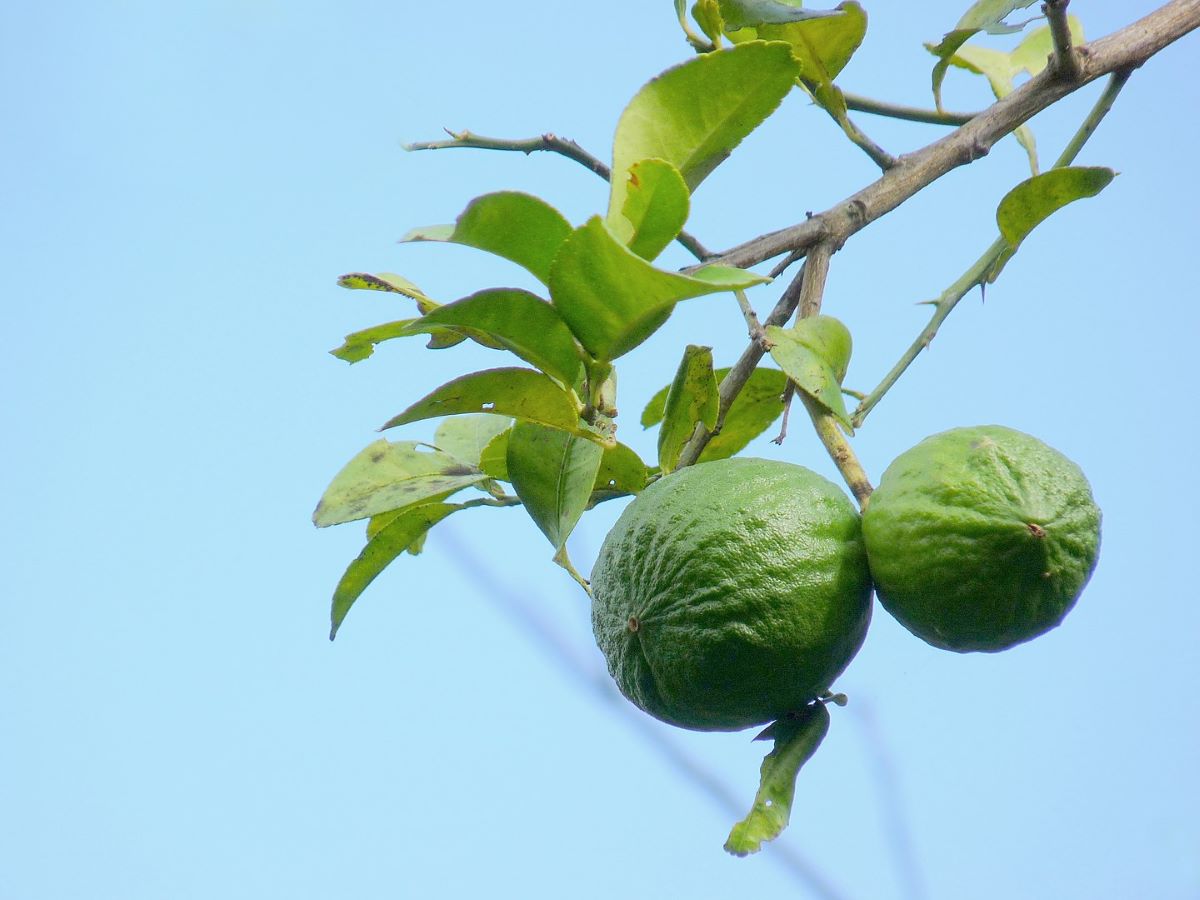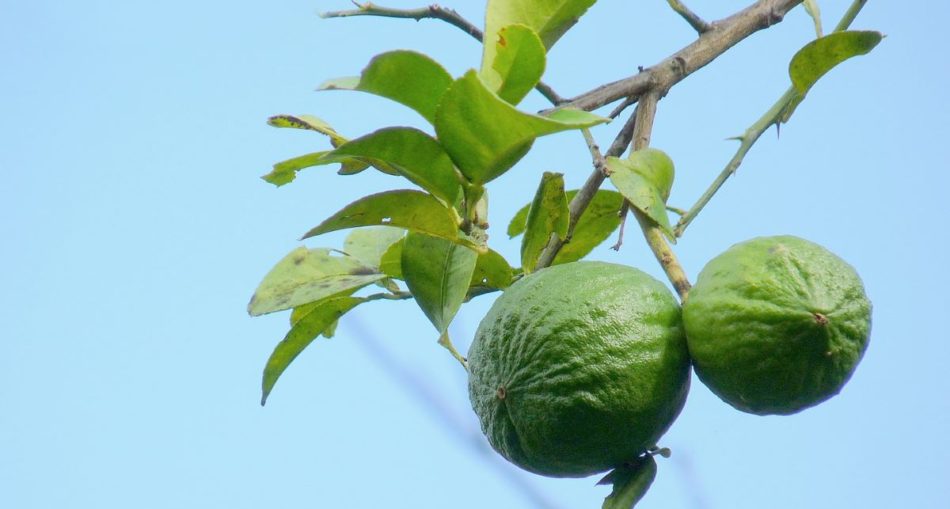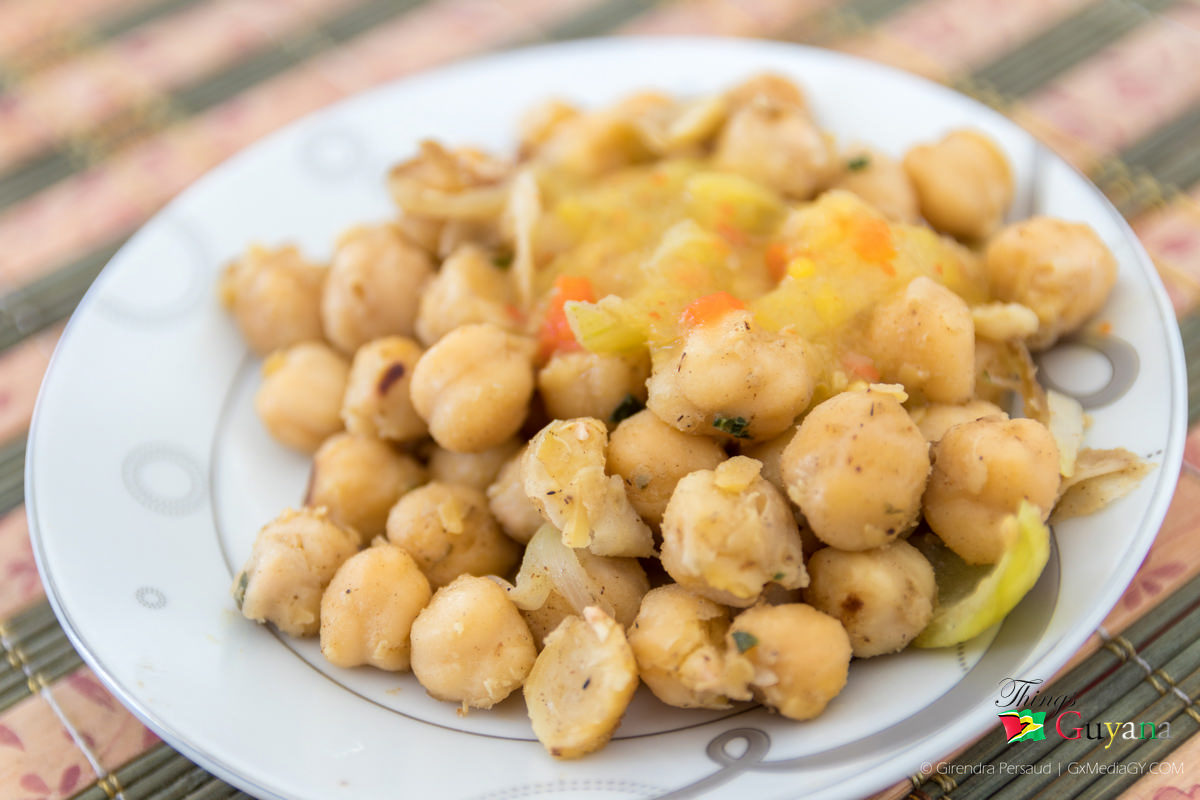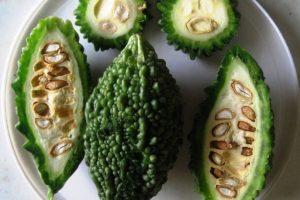Limes are the third most-produced citrus in Guyana, apart from oranges and tangerines. The Key Lime or Citrus aurantiifolia variety is widely grown while the Tahiti or Persian Limes (Citrus latifolia) are grown on a smaller scale in Guyana. Many Guyanese would use lime in their dishes like fish curry or to make swank – our version of lemonade. While the scientific name of this particular citrus is Citrus aurantiifolia, it has several common names including, bartender’s lime, Key Lime, Mexican Lime, Omani Lime or West Indian Lime.

West Indian Lime – Photo By © 2009 Jee & Rani Nature Photography (License: CC BY-SA 4.0), CC BY-SA 4.0, https://commons.wikimedia.org/w/index.php?curid=30883648
Origin of West Indian Lime
Key Lime or West Indian Lime is a hybrid of the Citrus micrantha and Citrus medica plant species. Lime is said to have originated in India. The Arabs brought limes to Eastern Mediterranean and were eventually introduced to the West Indies by Christopher Columbus.
Scientific Classification Of West Indian Lime
- Kingdom: Plantae
- Clade: Tracheophytes
- Clade: Angiosperms
- Clade: Eudicots
- Clade: Rosids
- Order: Sapindales
- Family: Rutaceae
- Genus: Citrus
- Species: C. × aurantiifolia
Description of West Indian Lime
The Citrus aurantiifolia is an evergreen tree that resembles a shrub about seven (7) to eight (8) feet in height with glossy, dark green leaves. The fruits or the limes are oval-shaped, similar to walnuts in shape and size. West Indian Limes are typically dark green but turn yellow as the fruit ripens. The seeds are a pale yellow colour. As opposed to Persian Limes, Key Limes has a stronger aroma, more seeds a higher acidity and is generally smaller.
Nutritional Value Lime
One Lime contains approximately
- 11 calories
- 3.7 g of carbohydrate
- 0.74 g of sugar
- 0.1 g of fibre
- 0.13 g of protein
Traditional Uses of West Indian Lime
The lime is an aromatic, astringent, cooling herb. Various part of the plant are used medicinally, especially the leaves, fruit, peel and essential oils
- An infusion of the West Indian Lime leaves is used to treat bilious, colds, and headaches.
- When mixed with Renealmia guianensis leaves in an infusion, West Indian Lime leaves can induce an abortion.
- For very hot feet, leaves are combined with Begonia glabra and Ocimum campechianum to make a bath.
- Lime juice is used to treat viccis – a fever which causes want to sleep and uncontrolled, relaxed digestive muscles.
- The juice of the fruit is also added to various medicines to treat common chest cold, diarrhoea and fevers and treats ground itch and dandruff.
- For snakebites, it is mixed with grated garlic and water and drank.
- The juice is also applied on the outside to cleanse wounds.
- The root of Key Limes are contraceptive and anthelmintic, when boiled and mixed with alcohol and drank it can abort a foetus.
- It is also used in the treatment of haemorrhages and venereal disease.
Culinary Uses of West Indian Lime
- West Indian Limes are used in desserts mainly tart and sweet.
- They are also widely used in sweet and sour cocktails and marinades as garnish.
- Lime juice is used in syrups and a key ingredient in key lime pie.
Interesting Tip
- The young leaves and flowers of all citrus plants including West Indian Lime are edible.
Other Uses of West Indian Lime
- An essential oil called lime-leaf oil is obtained from the leaves.
- lime oil extracted from the peels of this citrus are used in the manufacturing of soap, chewing gum, perfume, food, and sweets.
- A semi-drying oil, obtained from the seeds is also used in soap making.
- Lime plants are great to make into hedges since they are well adapted for this purpose
Health Benefits of West Indian Lime
- Good source of antioxidants – Limes are rich in flavonoids, limonoids, kaempferol, quercetin, and ascorbic acid, antioxidants in our bodies which defend cells against molecules called free radicals that lead to diabetes, cancer among other chronic conditions.
- High in Vitamin C – Vitamin is nothing new to us. It helps to protect against infections and diseases by increasing the production of white blood cells in the body. Vitamin C found in Limes can also promote healthy skin.
- May reduce risk of heart disease – Vitamin C in Limes may fight against atherosclerosis — a disease that causes plaque buildup in your arteries. It may also help to lower blood pressure, therefore, reducing the risk of heart disease.
- Increased Iron absorption – Using Limes may increase iron levels in the blood and there is less risk of anaemia.
- Helps with asthma – Limes help to fight off allergens that enter the lungs. The citric acid in its juice strengthens the lung tissue and improves lung function.
About West Indian Lime
Limes are an integral part of Guyanese food and drink traditions, sprinkled over fish, added to pot roast or made into swank. You can be sure to find them growing in a lot of yards in the countryside of Guyana. The West Indian Lime is a great citrus fruit whether used in food, for health reasons or for its wonderful scent. You can find fresh limes parcelled off at your local market so the next time you see them, don’t hesitate to pick up a handful.
Article References
- https://www.ecofog.gf/giec/doc_num.php?explnum_id=983
- https://www.medicalnewstoday.com/articles/304448#benefit
- https://www.thespruceeats.com/what-are-key-limes-1807847
- http://www.foodreference.com/html/artkeylimes.html
- http://tropical.theferns.info/viewtropical.php?id=Citrus+aurantiifolia
- https://en.wikipedia.org/wiki/Key_lime
- https://www.healthline.com/nutrition/limes#uses
- https://www.organicfacts.net/health-benefits/vitamins/health-benefits-of-vitamin-c-or-ascorbic-acid.html
- https://www.swansonvitamins.com/blog/lindsey/9-health-benefits-of-limes-and-lime-water
- https://www.organicfacts.net/health-benefits/vitamins/health-benefits-of-vitamin-c-or-ascorbic-acid.html








1 Comment